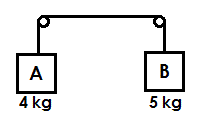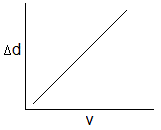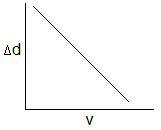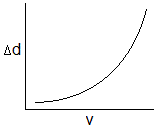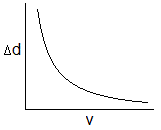|
| 1 |
Go |
Q:
|
Three blocks each of mass m are connected by massless strings as shown in the figure below. The rightmost block is pulled to the right by a force F causing the entire system to accelerate. Assuming no friction, what is the net force experienced by the middle block?
 |
|
|
|
|
Tags:
Forces | |
|
| 2 |
Go |
Q:
|
A 100-newton weight is suspended by two cords as shown in the figure below. The tension in the slanted cord is
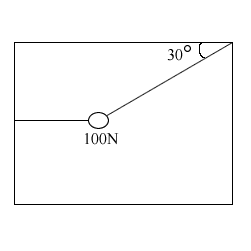 |
|
A
|
200 N |
B
|
100 N |
C
|
50 N |
D
|
250 N |
|
|
|
Tags:
Forces | Equilibrium | |
|
| 3 |
Go |
Q:
|
If all the forces acting on an object balance so that the net force is zero, then |
|
A
|
the object's direction of motion can change, but not its speed |
B
|
the object's speed will decrease |
C
|
the object must be at rest |
D
|
none of the above |
|
|
|
Tags:
Forces | Equilibrium | |
|
| 4 |
Go |
Q:
|
If the distance between two bodies increases four times, what happens to the gravitational force between them? |
|
A
|
Increases 4 times |
B
|
Decreases 4 times |
C
|
Increases 16 times |
D
|
Decreases 16 times |
|
|
|
Tags:
Forces | |
|
| 5 |
Go |
Q:
|
For satellites, orbit paths are extremely sensitive. In order for a satellite to reach a unique destination, all forces of gravity must be examined so that coordinates are not shifted in any way. To prevent this, a particular satellite of mass S is able to decrease its mass by detaching unnecessary mass (which was once necessary for exiting the atmosphere). An asteroid of mass A comes very close to the satellite, exerting a gravitational force of X on the satellite. Say that Fmax is the maximal gravitational force that the satellite can bear without going off course. If we assume that X>Fmax, then how much mass should the satellite remove in order to experience the maximal gravitational force and not being thrown off track? (Assume that the distance between the asteroid and the satellite is r and remains constant) |
|
A
|
X - r2(X - Fmax)/GA |
B
|
r2(Fmax - X)/GA |
C
|
(X - Fmax)/GA |
D
|
r2(X - Fmax)/GA |
|
|
|
Tags:
Forces | |
|
| 6 |
Go |
Q:
|
Suppose that you have an opened cylinder filled to the top with two equal quantities of fluids. Fluid A has a density of a and Fluid B has a density of b. If the height of the cylinder is x, what is the pressure of the fluid system at the bottom of the cylinder (assume that atmospheric pressure is Patm and that gravity is g)?
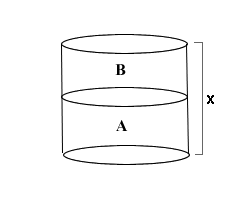 |
|
A
|
(bgx)/2 + (agx)/2 |
B
|
(bgx)/2 + agx |
C
|
Patm + (bgx)/2 + agx |
D
|
Patm + (bgx)/2 + (agx)/2 |
|
|
|
Tags:
Forces | Fluids | |
|
| 7 |
Go |
Q:
|
A cyclist is riding his bicycle in the positive x-axis. If one looks at the point of contact of the front wheel with the surface (pretending the x-axis is a surface with a coefficient of friction), where is the direction of the force due to friction? |
|
A
|
In the negative x-axis |
B
|
In the positive y-axis |
C
|
In the negative y-axis |
D
|
In the positive x-axis |
|
|
|
Tags:
Forces | |
|
| 8 |
Go |
Q:
|
At terminal velocity, an object has |
|
A
|
reached maximum elevation in its projectile arc with a vertical velocity of 0 m/s |
B
|
reached an equilibrium between the force of gravity and the drag force due to the air |
C
|
spent all of its potential energy |
D
|
reached maximum velocity and begun to decelerate |
|
|
|
Tags:
Forces | Equilibrium | |
|
| 9 |
Go |
Q:
|
The gravitational force between planets X and Y is F.
If both planets double in mass, and the distance between
them triples, what is the force between them? |
|
A
|
1/3 F
|
B
|
4/9 F |
C
|
4/3 F |
D
|
2/3 F |
|
|
|
Tags:
Forces | |
|
| 10 |
Go |
Q:
|
A block rests on a ramp of 45 degrees. The block is not moving, but is at its threshold; the slightest force will cause it to slide down the ramp. As it rests, what is the approximate ratio of forces due to static friction versus kinetic friction experienced by the block? |
|
A
|
1:1 static:kinetic |
B
|
1:0 static:kinetic |
C
|
0:1 static:kinetic |
D
|
2:1 static:kinetic |
|
|
|
Tags:
Forces | |
|
| 11 |
Go |
Q:
|
An object has a net force of 0 N placed on it. It can be guaranteed that the object |
|
A
|
is stationary |
B
|
is in constant motion |
C
|
is not accelerating |
D
|
in constant acceleration or deceleration |
|
|
|
Tags:
Forces | |
|
| 12 |
Go |
Q:
|
The buoyant force on a sunken ship block of iron is equal to: |
|
A
|
the weight of the iron block |
B
|
the weight of the water displaced by the iron block |
C
|
the weight of the pressure difference between the surface of the water and the center of mass of the block |
D
|
the weight of the water below the iron block |
|
|
|
Tags:
Forces | |
|
| 13 |
Go |
Q:
|
Observe the diagram below. What is T1/T2? Assume g = 10 m/s2
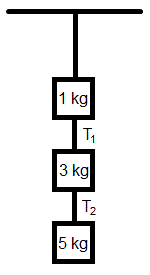 |
|
|
|
|
Tags:
Forces | |
|
| 14 |
Go |
Q:
|
A rope is attached to a wall, and the rope is tied onto a horse. The horse is able to walk away from the wall to generate a tension T in the rope. If the rope is tied onto two horses, and they each walk away from each other with the same force as the original horse walking away from the wall, what is the tension in the rope? |
|
|
|
|
Tags:
Forces | |
|
| 15 |
Go |
Q:
|
An individual rides his bicycle in the positive x-axis. What is the direction of the frictional force at the point of the tire where it makes contact with the ground. |
|
A
|
Positive y-axis |
B
|
Negative y-axis |
C
|
Positive x-axis |
D
|
Negative x-axis |
|
|
|
Tags:
Forces | |
|
| 16 |
Go |
Q:
|
On which of the following surfaces would a moving sled
encounter the least friction?
I. Coefficient of static friction: 0.60
Coefficient of kinetic friction: 0.40
II. Coefficient of static friction: 0.40
Coefficient of kinetic friction: 0.40
III. Coefficient of static friction: 0.50
Coefficient of kinetic friction: 0.50 |
|
A
|
I only |
B
|
II only |
C
|
I and II |
D
|
I, II, and III |
|
|
|
Tags:
Forces | |
|
| 17 |
Go |
Q:
|
A mass of 1 kg is tied to a 2-meter string and spun in circles at 60 rpm. What is the tension in the string? Assume π = 3. |
|
A
|
9.8 N |
B
|
18 N |
C
|
72 N |
D
|
288 N |
|
|
|
Tags:
Forces | Quantitative Skills | |
|
| 18 |
Go |
Q:
|
A constant torque of τ will have greatest instantaneous force on which of the following discs? |
|
A
|
r = 5 m |
B
|
r = 50 cm |
C
|
r = 5 cm |
D
|
A, B, and C equally |
|
|
|
Tags:
Forces | |
|
| 19 |
Go |
Q:
|
A object of mass M with charge Q rests on a concrete floor with a coefficient of static friction Z. Another charge of Q is placed a distance R away from the object. The object remains stationary. What is the magnitude force of static friction on the object? |
|
A
|
MZ |
B
|
kQ2/R2 |
C
|
kQ2Z/R2 |
D
|
kQZ/R2 |
|
|
|
Tags:
Forces | Electrostatics | |
|
| 20 |
Go |
Q:
|
Place the following three scenarios in increasing order of gravitational force between two objects.
I. m1, m2, r
II. 2m1, m2, 2r
III. 2m1, m2, r |
|
A
|
I < III < II |
B
|
I < II < III |
C
|
II < I < III |
D
|
II < III < I |
|
|
|
Tags:
Forces | |
|
| 21 |
Go |
Q:
|
The total volume of a ship is 106 L. The ballast tanks have a volume of 105 L; these tanks can take in and expel water to raise and lower the boat. The mass of the empty ship and empty ballast tanks is 105 kg. If 50,000 kg of cargo are taken on to the boat, and the ballast tanks are filled to half their capacity, how much more cargo can the ship take before it sinks? |
|
A
|
200,000 kg |
B
|
750,000 kg |
C
|
800,000 kg |
D
|
850,000 kg |
|
|
|
Tags:
Forces | |
|
| 22 |
Go |
Q:
|
In the following diagram, the object is suspended from the two wires and is in static equilibrium. T1 is 10 N. What is T2? sin(30) = 0.5; sin(60) = 0.866.
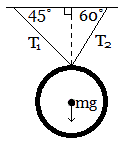 |
|
A
|
10 N |
B
|
(5√2)/2 N |
C
|
(5√2)/0.866 N |
D
|
10√2 N |
|
|
|
Tags:
Forces | |
|
| 23 |
Go |
Q:
|
A metal ball on a lake has a homogeneous density of 0.30 g/mL and a volume of 5 L. What percentage of the volume of the ball rests above the water? |
|
|
|
|
Tags:
Forces | Quantitative Skills | |
|
| 24 |
Go |
Q:
|
A 10-kg object sits on a 30° incline as shown in the diagram below.
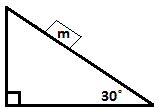
What is the minimum coefficient of static friction needed to keep the object unmoving on the incline? Assume g = 10 m/s2. Note: the diagram is not drawn to scale. |
|
A
|
sin(60°) |
B
|
sin(30°) |
C
|
sin(60°)/sin(30°) |
D
|
sin(30°)/sin(60°) |
|
|
|
Tags:
Forces | Quantitative Skills | |
|
| 25 |
Go |
Q:
|
The equation to determine the force between two charged particles is F = kQ1Q2/r2. A change in which of the following parameters will affect the constant k? |
|
A
|
the magnitude of the charge of either of the charged bodies |
B
|
the voltage between the two charged bodies |
C
|
the distance between the two charged bodies |
D
|
the medium between the two charged bodies |
|
|
|
Tags:
Forces | |
|
| 26 |
Go |
Q:
|
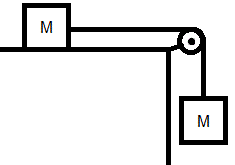
Where M = M, g = 10 m/s2, and the pulley is frictionless, what must the coefficient of static friction be in order for the system to remain stationary? |
|
A
|
0 |
B
|
0.1 |
C
|
1 |
D
|
Impossible to determine based on the given information. |
|
|
|
Tags:
Forces | |
|
| 27 |
Go |
Q:
|
A ball massing 10 kg hangs at the end of a massless, 5m string. The ball is then set swinging with a maximum velocity of 5 m/s. What is the maximum tension in the rope? |
|
A
|
100 N |
B
|
150 N |
C
|
175 N |
D
|
300 N |
|
|
|
Tags:
Periodic Motion | Forces | |
|
| 28 |
Go |
Q:
|
A cube of metal masses 50 kg and has an apparent mass of 30 kg when immersed in water. What is the volume of the cube? |
|
A
|
10 L |
B
|
20 L |
C
|
80 L |
D
|
Cannot be determined from the given information. |
|
|
|
Tags:
Forces | Quantitative Skills | |
|
| 29 |
Go |
Q:
|
Two skydivers open parachutes of different sizes and fall at the same constant velocity. One skydiver is three times heavier than the other. What are the relative upward forces acting on the skydivers? |
|
A
|
The upward force acting on both skydivers is the same. |
B
|
The upward force acting on the lighter skydiver is three times greater than the upward force acting on the heavier skydiver. |
C
|
The upward force acting on the heavier skydiver is three times greater than the upward force on the lighter skydiver. |
D
|
This is impossible. The heavier skydiver will fall faster than the lighter one. |
|
|
|
Tags:
Forces | |
|
| 30 |
Go |
Q:
|
A 10 m seesaw is set-up with the point of rotation in the middle. A 15 kg mass is placed 1 m from this point on one side. How far is the heavier mass from the 5 kg mass (on the other side of the focal point) if the seesaw is balanced?
|
|
|
|
|
Tags:
Forces | Quantitative Skills | |
|
| 31 |
Go |
Q:
|
Two pistons, filled with an incompressible fluid, are connected to each other. A force of 10 N is applied on one piston, which moves 3 cm. A force is 5 N is on the other piston. How far does this second piston move? |
|
A
|
1.5 cm |
B
|
3 cm |
C
|
6 cm |
D
|
9 cm |
|
|
|
Tags:
Forces | Quantitative Skills | |
|
| 32 |
Go |
Q:
|
An object slides down an incline with a coefficient of kinetic friction of 0.45. At which point along the incline is the frictional force the greatest? Neglect air resistance. |
|
A
|
At the top of the incline |
B
|
In the middle of the incline |
C
|
At the bottom of the incline |
D
|
The force is constant at all times during the slide |
|
|
|
Tags:
Forces | |
|
| 33 |
Go |
Q:
|
Anna masses 30 kg and is on a seesaw with her older sister who masses 50 kg. The see-saw is 10m long and its center is balanced on the fulcrum. If Anna is sitting at one end of the see-saw, where on the other side must her older sister sit such that the see-saw will be balanced? |
|
A
|
1 m from the center |
B
|
2 m from the center |
C
|
2 m from the end |
D
|
At the end |
|
|
|
Tags:
Forces | Quantitative Skills | |
|
| 34 |
Go |
Q:
|
Which of the following does not depend on the mass of the object involved? |
|
A
|
the period of a pendulum composed of a 500g ball at the end of a string |
B
|
the period of a horizontal spring attached to a 1 kg weight |
C
|
the period of a vertical spring attached to a 750g weight |
D
|
the frictional force on a 100 kg mass a sliding down an incline with a coefficient of kinetic friction
of 0.28 |
|
|
|
Tags:
Forces | Periodic Motion | |
|
| 35 |
Go |
Q:
|
A buoyant ball sits in the water with 5 L of the ball sitting below the surface and 1 L of the ball sitting above the surface as in the diagram below.
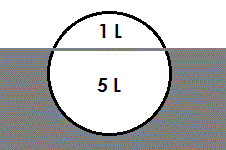
What is the maximum mass that can be placed atop the ball before it is completely submerged? |
|
A
|
1 kg |
B
|
4 kg |
C
|
5 kg |
D
|
6 kg |
|
|
|
Tags:
Forces | |
|
| 36 |
Go |
Q:
|
When comparing the motion of a projectile through a fluid such as air, its distance traveled will be |
|
A
|
less than the distance traveled in a vacuum because friction predicts a loss of total energy to heat |
B
|
greater than the distance traveled because friction predicts a loss of total energy to heat |
C
|
less than the distance traveled in a vacuum because friction predicts a gain in total energy due to heat |
D
|
greater than the distance traveled because friction predicts a gain in total energy due to heat |
|
|
|
Tags:
Kinematics | Forces | |
|
| 38 |
Go |
Q:
|

In the schematic above, what is the tension T2 if the system is moving to the right at 10 m/s? Assume μk = 0.50. |
|
A
|
25 N |
B
|
50 N |
C
|
75 N |
D
|
85 N |
|
|
|
Tags:
Forces | |
|
| 39 |
Go |
Q:
|
Airfoils can generate lower pressures on their top surfaces than their bottom surfaces which lie at atmospheric pressure. This helps air on the bottom push the airfoil upwards. For a flying 500kg airfoil with an area of 20 m2, what is the maximum pressure on its top surface? Assume air pressure is 100 kPa. 1 Pa = 1 N/m2 |
|
A
|
0 Pa |
B
|
250 Pa |
C
|
75000 Pa |
D
|
99750 Pa |
|
|
|
Tags:
Forces | Quantitative Skills | |
|
| 40 |
Go |
Q:
|
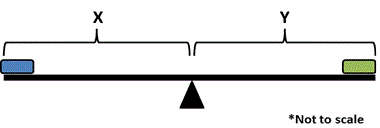
A large board is held up by a pivot, as shown in the diagram above. It is known that 3X = Y. For the board to be in static equilibrium, which of the following must be true?
|
|
A
|
The mass of the left block must be three times less than the mass of the right block |
B
|
The mass of the right block must be three times less than the mass of the left block |
C
|
The force of gravity on the left and right blocks are equal |
D
|
Net torque around the pivot need not be zero |
|
|
|
Tags:
Forces | Equilibrium | Quantitative Skills | |
|
| 41 |
Go |
Q:
|
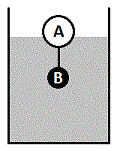
Ball A is buoyant in an unknown liquid and has a mass of a with a volume V. A non-buoyant Ball B of mass b and volume R is suspended from Ball A. If the two remain buoyant, what is the buoyant force on the two balls combined?
|
|
A
|
ρ(V + R) |
B
|
(a + b)g |
C
|
(a + b)/(V + R) |
D
|
Va/Rb |
|
|
|
Tags:
Forces | Quantitative Skills | |
|
| 42 |
Go |
Q:
|
Which of the following cannot be a coefficient for kinetic friction if we know that the coefficient of static friction is 0.4? |
|
|
|
|
Tags:
Forces | Equilibrium | |
|
| 43 |
Go |
Q:
|
As the mass of a planet increases, the weight of an object on the planet will |
|
A
|
only increase if the object's mass increases |
B
|
increase linearly with the planet's mass |
C
|
increase proportional to the square of the planet's mass |
D
|
increase proportional to the square of the object's mass |
|
|
|
Tags:
Forces | Quantitative Skills | |
|
| 44 |
Go |
Q:
|
A bicyclist biking along the path decides to analyze the physics behind riding the bicycle. Which of the following is an incorrect conclusion? |
|
A
|
Friction is primarily responsible for propelling the bicycle forward |
B
|
The kinetic frictional force does not affect the bicyclist when in motion |
C
|
The force of friction of the ground on the bicycle tire is in the forward direction (from the perspective of the bicyclist) |
D
|
In the absence of friction, the tires can still propel the bicycle forward |
|
|
|
Tags:
Forces | |
|
| 45 |
Go |
Q:
|
A sphere of volume V floats in the middle of a river. The water has density d and the sphere displaces a volume X of the water. Which of the following expressions correctly gives the relationship for the mass of the sphere? (g refers to the acceleration due to gravity) |
|
A
|
dX |
B
|
dV2/X |
C
|
dV/X2 |
D
|
dgX |
|
|
|
Tags:
Forces | Quantitative Skills | |
|
| 46 |
Go |
Q:
|
The escape velocity is the velocity at which the gravitational potential energy of an object is equal to its kinetic energy and reflects the speed at which an object must move in order to escape the gravitational influence of the surface on which it rests. Which of the following accurately reflects the equation for the escape velocity of any object? |
|
A
|
√(2GMh/r) |
B
|
√(2GM/r2) |
C
|
√(2GMm/r2) |
D
|
√(2GM/r) |
|
|
|
Tags:
Forces | Energy & Work | |
|
| 47 |
Go |
Q:
|
In a far off planet, it is found that the coefficients of kinetic and static friction are both negative. What effect would this have on riding a bicycle? |
|
A
|
You would not be able to move the bicycle |
B
|
The wheels would spin but the bike would neither move forward nor backward |
C
|
The bicycle would move by itself in perpetual motion |
D
|
None of the above |
|
|
|
Tags:
Forces | |
|
| 48 |
Go |
Q:
|
A block slides sits on an incline angled 30° to the horizontal. If the block masses 12 kg, what is the minimum coefficient of kinetic friction of the surface? |
|
A
|
(√3)/2 |
B
|
1/√3 |
C
|
1/2 |
D
|
√3 |
|
|
|
Tags:
Forces | Quantitative Skills | |
|
| 49 |
Go |
Q:
|
A ball with an average density of 1.3 g/cm3 is submerged at the bottom of a tank of water. Which of the following is true about this system? |
|
A
|
The volume of water displaced is greater than the volume of the ball. |
B
|
There is no buoyant force on the ball since it is sunken at the bottom of the tank. |
C
|
The weight of the water displaced is less than the weight of the ball. |
D
|
None of the above is true. |
|
|
|
Tags:
Forces | Quantitative Skills | |
|
| 50 |
Go |
Q:
|
A box of unknown mass slides 40 m down a frictionless slide. If the box began at a height of 10 m above ground, what is the acceleration of the box? |
|
A
|
2.5 m/s2 |
B
|
4 m/s2 |
C
|
10 m/s2 |
D
|
25 m/s2 |
|
|
|
Tags:
Forces | Quantitative Skills | |
|
| 51 |
Go |
Q:
|
The normal force on a stationary object is always |
|
A
|
equal to the force of gravity on the object. |
B
|
equal to or less than the force of gravity on the object. |
C
|
equal to or greater than the force of gravity on the object. |
D
|
less than the force of gravity on the object. |
|
|
|
Tags:
Forces | |
|
| 52 |
Go |
Q:
|
As two objects of non-negligible mass move toward one another, their acceleration towards each other |
|
A
|
increases. |
B
|
remains the same. |
C
|
decreases. |
D
|
increases or decreases, depending on their masses. |
|
|
|
Tags:
Forces | |
|
| 53 |
Go |
Q:
|
Objects have a terminal velocity due to air resistance but do not have a similar terminal velocity due to friction when sliding across surfaces. This is because: |
|
A
|
objects sliding down inclines are completely subject to the force of gravity while objects falling through the air are not. |
B
|
air resistance is proportional to velocity while kinetic friction is irrespective of velocity. |
C
|
kinetic friction is weaker than static friction. |
D
|
objects attached to surfaces are not subject to air resistance. |
|
|
|
Tags:
Forces | |
|
| 54 |
Go |
Q:
|
A cylindrical cup is placed into water and floats with 3 cm submerged underwater and 7 cm above the surface of the water. If the mass of the cup is 500 g, how much water must be added to the cup for it to sink completely? Assume the mass of the cup is uninformly distributed along its vertical axis. (Note: the density of water is 1 g/mL)
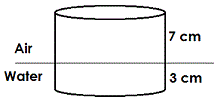 |
|
A
|
500 mL |
B
|
700 mL |
C
|
1170 mL |
D
|
The answer cannot be determined with the given information. |
|
|
|
Tags:
Forces | Quantitative Skills | |
|
| 55 |
Go |
Q:
|
How much would a 15kg object weigh on the surface of a planet with twice the mass and three times the radius of the earth? |
|
A
|
33 N |
B
|
100 N |
C
|
150 N |
D
|
330 N |
|
|
|
Tags:
Forces | Quantitative Skills | |
|
| 56 |
Go |
Q:
|
A large ball with a mass of 500 kg is being lowered on New Year's Eve. It unhinges at a height of 20 m from a motionless position and falls directly to the ground. The ball comes to a halt upon impact with the ground in 0.1 seconds. How much force is exerted on the ground by the ball? |
|
A
|
2 x 103 N |
B
|
104 N |
C
|
105 N |
D
|
2 x 106 N |
|
|
|
Tags:
Forces | Quantitative Skills | |
|
| 57 |
Go |
Q:
|
Which of the following must remain constant between two different planets so that acceleration due to gravity will remain the same? |
|
A
|
mass of the two planets |
B
|
density of the two planets |
C
|
radius of the two planets |
D
|
the ratio of m/r2 of the two planets |
|
|
|
Tags:
Forces | |
|
| 58 |
Go |
Q:
|
A 5000kg object is being lifted on a fulcrum. If the object is sitting 1 meter from the pivot point, how long does the other end of the lever need to be to lift the object if only 100 N of force are applied? |
|
A
|
50 m |
B
|
100 m |
C
|
500 m |
D
|
5000 m |
|
|
|
Tags:
Forces | Quantitative Skills | |
|
| 59 |
Go |
Q:
|
An object is submerged and held underwater, with its buoyancy unknown. Which of the following must hold true? |
|
A
|
ρVg > mg |
B
|
ρVg < mg |
C
|
Vdisplaced = mobject / ρobject |
D
|
ρobjectg = Vdisplaced |
|
|
|
Tags:
Forces | |
|
| 60 |
Go |
Q:
|

A fulcrum with a lever is set up as in the diagram above. Ball A masses 150 kg and sits 80 cm from the pivot. Ball B masses 20 kg and sits 2 m from the pivot. If Ball C masses 5 kg, how far away from the pivot does it sit of the lever is in equilibrium? |
|
A
|
1.6 m |
B
|
8 m |
C
|
16 m |
D
|
20 m |
|
|
|
Tags:
Forces | Equilibrium | Quantitative Skills | |
|
| 61 |
Go |
Q:
|
A block sits atop an incline at 30° to the horizontal. If the block masses 5 kg and is not sliding down the incline due to friction, what is the minimum coefficient of friction that is present on the incline? Note: assume g = 10 m/s2. |
|
|
|
|
Tags:
Forces | Quantitative Skills | |
|
| 62 |
Go |
Q:
|
For system with a pivot and a lever, by what magnitude does the torque change when the radius is doubled? |
|
|
|
|
Tags:
Forces | |
|
| 63 |
Go |
Q:
|
Which of the following expressions describes the work done by air resistance on a falling object between the time when it reaches its terminal velocity and the time when it impacts the ground? |
|
A
|
mgh |
B
|
m(gh - (1/2)vterminal2) |
C
|
√2gh |
D
|
(1/2)vterminal2 |
|
|
|
Tags:
Forces | Energy & Work | Quantitative Skills | |
|
| 64 |
Go |
Q:
|
What is the maximum mass that a car can tow along a surface if the coefficient of kinetic friction is 0.67 and the car is able to apply a towing force of 2000 N? |
|
A
|
300 kg |
B
|
3000 kg |
C
|
1340 kg |
D
|
200 kg |
|
|
|
Tags:
Forces | Quantitative Skills | |
|
| 65 |
Go |
Q:
|
A force F is placed on the block system below and accelerates it at 3 m/s2. How many times greater is the tension at Point II than at Point I?
 |
|
|
|
|
Tags:
Forces | Quantitative Skills | |
|
| 66 |
Go |
Q:
|
A frog is launched into the air from a nearby rocket blast. As it sails through the air, it reaches its terminal velocity and thankfully lands in a pool of water which decelerates it uniformly over 0.2 seconds. If the frog's terminal velocity is 3 m/s and it has a mass of 100 grams, how much force is exerted on the frog's body during its landing in the water? |
|
A
|
1.5 N |
B
|
0.6 N |
C
|
0.67 N |
D
|
The answer cannot be determined with the given information. |
|
|
|
Tags:
Forces | Quantitative Skills | |
|
| 67 |
Go |
Q:
|
A door knob requires 0.2 Nm to turn. If a child is only able to apply a 2kg mass onto the handle, what is the minimum distance from the center of the knob that the child must hold it in order to turn? |
|
A
|
10 cm |
B
|
100 cm |
C
|
1 cm |
D
|
0.1 cm |
|
|
|
Tags:
Forces | Quantitative Skills | |
|
| 68 |
Go |
Q:
|
A tub of pure water holds a floating craft in the middle. A student slowly adds salt to the tub, increasing the molarity of the tub to 3 M. Which of the following describes what the floating craft will do? Assume the level of the water remains constant. |
|
A
|
The craft will sink deeper into the water. |
B
|
The craft will retain its current level of buoyancy. |
C
|
The craft will rise higher on the water. |
D
|
The craft will sink to the bottom of the tub. |
|
|
|
Tags:
Forces | Solutions | |
|
| 69 |
Go |
Q:
|
The gravitational force between the Earth and Neptune is 4.54 x 106 N. If Jupiter is 3 times closer to the Earth and 4 times more massive than Neptune, what is the gravitational force between the Earth and Jupiter? |
|
A
|
(9/4) · 4.54 x 106 N |
B
|
(4/9) · 4.54 x 106 N |
C
|
12 · 4.54 x 106 N |
D
|
36 · 4.54 x 106 N |
|
|
|
Tags:
Forces | Quantitative Skills | |
|
| 70 |
Go |
Q:
|
A man travels to a planet that has twice the radius of the earth and twice the mass. His weight on that planet compared to his weight on earth is:
|
|
A
|
Doubled |
B
|
Tripled |
C
|
Halved |
D
|
Quadrupled |
|
|
|
Tags:
Forces | |
|
| 71 |
Go |
Q:
|
A solid dodecahedron has a weight of 100 N with a cross-sectional length of 50 cm from each pair of the closest opposite vertices. It is immersed in water and its weight is now 80 N. What is the density of the dodecahedron? Assume ρwater = 1.00 g/mL and g = 10 m/s2. |
|
A
|
0.2 g/mL |
B
|
2 g/mL |
C
|
5 g/mL |
D
|
50 g/mL |
|
|
|
Tags:
Forces | Quantitative Skills | |
|
| 72 |
Go |
Q:
|
A hand held shopping basket 0.62 m long has a 1.81 kg cartoon of milk at the left end and a 0.72 kg box of cereal at the right end. Where should a 1.80 kg container of orange juice be placed so that the basket balances at its center? |
|
A
|
0.18 m from the center and on the same side as the milk cartoon |
B
|
0.18 m from the center and on the same side as the cereal box |
C
|
0.26 m from the center and on the same side as the milk carton |
D
|
0.26 m from the center and on the same side as the cereal box |
|
|
|
Tags:
Forces | Quantitative Skills | |
|
| 73 |
Go |
Q:
|
An engineer is attempting to lift a 5000-kg object using a lever and fulcrum as a pivot. The object sits at a distance of 5 m from the pivot. If he can only apply 250 N of force onto the lever, at what distance must he apply force to the lever to be able to lift the object? |
|
A
|
40 m |
B
|
400 m |
C
|
1000 m |
D
|
5000 m |
|
|
|
Tags:
Forces | Quantitative Skills | |
|
| 74 |
Go |
Q:
|
A block of ice (ρ = 0.92 g/cm3) floats in a tub of water. If the ice is left to melt with no removal or addition of water, what will happen to the level of the water as the ice melts? |
|
A
|
The water level will fall. |
B
|
The water level will remain the same. |
C
|
The water level will rise. |
D
|
The water level will rise or fall depending on atmospheric pressure. |
|
|
|
Tags:
Forces | |
|
| 75 |
Go |
Q:
|
How much force is applied on a 5g bullet if it is accelerated from rest to 800 m/s in the space of 0.001 seconds? |
|
A
|
4 N |
B
|
160 N |
C
|
1280 N |
D
|
4000 N |
|
|
|
Tags:
Forces | Quantitative Skills | |
|
| 76 |
Go |
Q:
|
An object with a mass of 8 grams is placed into an ethanol solution and appears to lose 3 grams of its mass. What is the approximate density of the object? Note: the density of ethanol is 0.8 g/mL. |
|
A
|
1.7 g/mL |
B
|
2.1 g/mL |
C
|
3.8 g/mL |
D
|
8 g/mL |
|
|
|
Tags:
Forces | Quantitative Skills | |
|
| 77 |
Go |
Q:
|
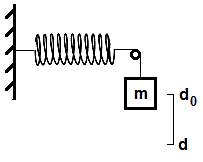
A mass hung over a single pulley is attached to a spring. As the mass is released from d0, it falls to its maximum amplitude of d. Which of the following diagrams accurately depicts the force the spring applies on the mass with respect to the displacement of the mass? |
|
|
|
|
Tags:
Forces | Quantitative Skills | |
|
| 78 |
Go |
Q:
|
Which of the following is the correct units for the constant G in the equation for the force of gravity between two masses? |
|
A
|
Nm-2kg2 |
B
|
m/s2 |
C
|
m/s |
D
|
Nm2kg-2 |
|
|
|
Tags:
Forces | |
|
| 79 |
Go |
Q:
|
A 20kg child sits on a swing with ropes 2 m long. The maximum speed during each swing is 4 m/s with an arc of 135°. What is the maximum tension in the swing? |
|
A
|
160 N |
B
|
200 N |
C
|
360 N |
D
|
240 N |
|
|
|
Tags:
Forces | Quantitative Skills | |
|
| 80 |
Go |
Q:
|
A 70kg person is walking on slippery ice. As the person takes a step, their leg extends 30° from normal, and their entire weight shifts onto the leg. What is the minimum coefficient of friction required for the ice to not let the person slip? |
|
A
|
0.23 |
B
|
0.50 |
C
|
0.57 |
D
|
0.87 |
|
|
|
Tags:
Forces | Quantitative Skills | |
|
| 81 |
Go |
Q:
|
Jars can be difficult to open due to the limited torque for the radius available on the lid. For a jar with a lid whose diameter is 10 cm, a lever is attached to the lid whose length extends to 20 cm from the lid's center. How many times more torque can be applied using the lever rather than simply turning the lid directly? |
|
A
|
The torque will remain constant |
B
|
The torque will double |
C
|
The torque will quadruple |
D
|
The torque will increase 16-fold |
|
|
|
Tags:
Forces | Quantitative Skills | |
|
| 82 |
Go |
Q:
|
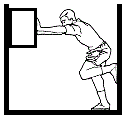
A person is pushing a box against a wall in order to keep it from sliding down. The force applied is directly perpendicular to the wall, which is perfectly vertical. If the coefficient of static friction is 0.65, how much force must be applied on the box to prevent it from sliding?
|
|
A
|
mg/0.65 |
B
|
0.65/mg |
C
|
(0.65)mg |
D
|
0.652/mg |
|
|
|
Tags:
Forces | Quantitative Skills | |
|
| 83 |
Go |
Q:
|

A cart with mass m is accelerated to a velocity v and collided with a spring as in the diagram above. Which of the following depicts the relationship between the maximum displacement of the spring upon collision and the velocity of the cart? |
|
|
|
|
Tags:
Kinematics | Forces | Quantitative Skills | |
|
| 84 |
Go |
Q:
|
How much force is applied onto a 50kg object to uniformly accelerate it from 5 m/s to 25 m/s in 8 seconds? |
|
A
|
31 N |
B
|
125 N |
C
|
156 N |
D
|
250 N |
|
|
|
Tags:
Forces | Quantitative Skills | |
|
| 85 |
Go |
Q:
|
A golf ball is placed into a pool of liquid metal, and floats on the surface. In order to completely submerge the ball, a force of F must be applied onto the ball. Which of the following expressions correctly describes the density of the golf ball relative to the liquid metal? |
|
A
|
mballg/(mballg + F) |
B
|
mballg/F |
C
|
mballg/(mballgF) |
D
|
mliquidg/(mballg + F) |
|
|
|
Tags:
Forces | Quantitative Skills | |
|
| 86 |
Go |
Q:
|
A 10 kg block is accelerated at 2 m/s2 up a frictionless plane inclined at 30 degrees to the horizontal. The force acting parallel to the plane pushing the block upwards is: |
|
A
|
100 N |
B
|
25 N |
C
|
50 N |
D
|
70 N |
|
|
|
Tags:
Kinematics | Forces | Quantitative Skills | |
|
| 87 |
Go |
Q:
|
A boat floating in water is filled with dense steel weights until the level of the water just reaches the rim so that if the boat sinks any further, it will take on water and sink. If foam balls with density less than that of water are added into the boat along with the steel weights, which of the following will happen to the boat? |
|
A
|
the boat will rise out of the water slightly because the foam balls have a lower density than the water |
B
|
the boat will do nothing because the foam balls have a lower density than the water |
C
|
the boat will sink because the foam balls have mass |
D
|
the boat will sink because the foam balls have a lower density than the water |
|
|
|
Tags:
Forces | |
|
| 88 |
Go |
Q:
|
A massless tether is tied to a block and held vertically over the block. If the block masses, 5kg, how much force is required to accelerate the block upward at 2 m/s2? Assume g = 10 m/s2. |
|
A
|
10 N |
B
|
50 N |
C
|
60 N |
D
|
20 N |
|
|
|
Tags:
Forces | Quantitative Skills | |
|
| 89 |
Go |
Q:
|
Theoretically, consider that a hole is dug through the surface of the Earth to the exact opposite side of the Earth (such that the hole passes through the precise center of the Earth). A ball is dropped into the hole. Which of the following holds true for acceleration (a) and velocity (v) of the ball when the ball makes its way to the center of the Earth (assume resistance due to air is zero)? |
|
A
|
a=0, v=0 |
B
|
|a|>0, v=0 |
C
|
a=0, |v|>0 |
D
|
|a|>0, |v|>0 |
|
|
|
Tags:
Kinematics | Forces | |
|
| 90 |
Go |
Q:
|
Which of the following is false regarding the normal force for an object placed on a surface (assume that the system is not accelerating and the only relevant forces are gravitational and normal force)? |
|
A
|
It is a force always perpendicular to the surface of contact |
B
|
It is a force exerted by the surface onto the object |
C
|
On a ramp with non-zero angle, its value is less than the value of the gravitational force |
D
|
It can exceed the gravitational force of an object (mg) |
|
|
|
Tags:
Forces | |
|
| 91 |
Go |
Q:
|
A spring with a k constant of 5 N/m is stretched 2 m from its equilibrium position by force F. Assume that this force continues to be applied as the spring is compressed to 2 m from its equilibrium position. How much work is performed by the force on the spring system? |
|
A
|
0 J |
B
|
20 J |
C
|
25 J |
D
|
40 J |
|
|
|
Tags:
Forces | Energy & Work | Quantitative Skills | |
|
| 92 |
Go |
Q:
|
A sphere with a volume of 5 m3 and mass 3 kg floats in the ocean. Which of the following represents the volume of the sphere which is NOT submerged in the ocean? Assume the density of the ocean is 1 kg/L. |
|
A
|
500 L |
B
|
1500 L |
C
|
4500 L |
D
|
4997 L |
|
|
|
Tags:
Forces | Quantitative Skills | |
|
| 93 |
Go |
Q:
|
A ball of weight 20N sits at the bottom of a 100m pool. Buoyancy force is calculated and is determined to be 30N. Approximately how long will it take for the ball to rise to the surface? |
|
A
|
4 seconds |
B
|
6 seconds |
C
|
8 seconds |
D
|
10 seconds |
|
|
|
Tags:
Kinematics | Forces | Quantitative Skills | |
|
| 94 |
Go |
Q:
|

A block of mass m rests atop an incline at an angle of θ and with a coefficient of static friction of μ. At the current angle, the block slides down the incline when released. Which of the following would help prevent the block from sliding down the incline when released?
I. Decreasing θ
II. Increasing m
III. Decreasing μ |
|
A
|
I only |
B
|
II and III only |
C
|
I and II only |
D
|
I and III only |
|
|
|
Tags:
Forces | Energy & Work | |
|
| 95 |
Go |
Q:
|
An athlete pulling a training sled claims he can't pull because the sled exerts the same force on him, keeping him in the same position. The sprinter is incorrect in the argument because: |
|
A
|
After friction is overcome, the reaction force is less than the pulling force |
B
|
After the sprinter gives a jerk and the sled is moving, its pulling force will be greater than the reaction to this force |
C
|
The action and reaction forces are acting on different bodies |
D
|
This law only applies to static situations |
|
|
|
Tags:
Forces | |
|
| 96 |
Go |
Q:
|
Two dirt paths lead up a hill, with Path A being 100 meters to the top of the hill, and Path B being 50 meters to the top. Compared to Path B, what is the average force exerted if you take Path A? |
|
A
|
The same as Path B |
B
|
One half as much |
C
|
Twice as much |
D
|
Four times as much |
|
|
|
Tags:
Forces | Energy & Work | |
|
| 97 |
Go |
Q:
|
A child playing in a river holds two identical rocks under the water. One of the rocks is held just beneath the surface and the other is held two feet under the surface. Compared to the force required to hold the first rock in place, how much force is needed to hold the second rock in place? |
|
A
|
Half the force |
B
|
Zero force, since the rock isn't influenced by surface tension |
C
|
The same force |
D
|
Twice the force |
|
|
|
Tags:
Forces | Quantitative Skills | |
|
| 98 |
Go |
Q:
|
A wooden box, whose top and bottom faces have twice the area as the 4 other faces, is being pushed across a floor at a constant speed. If the box is turned on any other side besides its top or bottom, what is the force required to push that box across the floor at the same speed? |
|
A
|
One half the original force |
B
|
Equal to the original force |
C
|
Twice the original force |
D
|
Four times the original force |
|
|
|
Tags:
Forces | |
|
| 99 |
Go |
Q:
|
A tennis ball is launched straight up into the air from a tennis ball launcher. Compared to the time it takes the ball to return from the top of its arc to the original position (t2), which of the following correctly describes the time (t1) it takes for the ball to reach the top of its arc? Assume air resistance. |
|
A
|
t1 is larger than t2 |
B
|
t1 is smaller than t2 |
C
|
t1 is equal to t2 |
D
|
Neither t1 or t2 can be determined, due to a lack of information
|
|
|
|
Tags:
Forces | Energy & Work | |
|
| 100 |
Go |
Q:
|
A container of water with a small, floating object is placed inside of an elevator. Given that only the container is in the elevator (no people), what happens to the object (compared to the water level) if the elevator accelerates upward? |
|
A
|
The acceleration effectively increases g, which results in more of the object being visible above the water line
|
B
|
The acceleration effectively increases g, which results in less of the object being visible above the water line
|
C
|
The acceleration effectively decreases g, which results in less of the object being visible above the water line
|
D
|
There is no change in the water level
|
|
|
|
Tags:
Fluids | Forces | |
|
| 101 |
Go |
Q:
|
A person is standing in an elevator that is accelerating upward. Which of the following correctly describes the upward force exerted by the elevator floor on the person? |
|
A
|
The person is accelerating upward, and the upward force from the elevator floor is larger than the downward weight of the person
|
B
|
The person is accelerating upward, but the upward force from the elevator floor is the same as the downward weight of the person
|
C
|
The person is not accelerating, but the upward force from the elevator floor is still larger than the downward weight of the person
|
D
|
The person is not accelerating, and the upward force from the elevator floor is the same as the downward weight of the person
|
|
|
|
Tags:
Forces | |
|
| 102 |
Go |
Q:
|
Which of the following choices best describes the simple situation of a person pulling a box across the floor? |
|
A
|
Since the person pulls forward harder on the box than the box pulls back on the person, the box moves |
B
|
Since action always equals reaction, the box only moves if the person is at least the same weight as the box |
C
|
The person's force on the box is as strong as the box's force on the person, but the frictional force on the box is large, while the frictional force on the person is backward and small |
D
|
The person's force on the box is as strong as the box's force on the person, but the frictional force on the box is small, while the frictional force on the person is forward and large |
|
|
|
Tags:
Forces | |
|
| 103 |
Go |
Q:
|
For a science project, a student makes a hole in the side of a container holding water, which then flows out in a parabolic trajectory. The student then drops the container from the top of a building, putting it in free fall. During this fall, what will happen to the flow of water out of the hole in the side of the container? |
|
A
|
The water follows the same parabolic trajectory
|
B
|
The water flows out in a straight line
|
C
|
The water stops flowing out of the hole
|
D
|
The water flows out in a curved, upward trajectory
|
|
|
|
Tags:
Fluids | Forces | |
|
| 104 |
Go |
Q:
|
A passenger seated in the passenger seat in a car takes off her seatbelt in order to reach for something in her bag. To avoid a pothole, the driver suddenly makes a sharp left turn, and the passenger hits the inside of the right-hand (passenger) door. Which of the following correctly describes the forces during the situation? |
|
A
|
Before and after the impact with the door, there is a rightward force pushing the passenger into the door.
|
B
|
Before and after the impact with the door, there is a leftward force pushing the passenger into the door.
|
C
|
At the time of impact, the door exerts a rightward force on the passenger
|
D
|
At the time of impact, the door exerts a leftward force on the passenger
|
|
|
|
Tags:
Forces | |
|
| 105 |
Go |
Q:
|
A high school science experiment is testing volume displacement and buoyant force by taping a solid weight on top of a solid styrofoam box. The box is then placed in a pool and floats. But, due to the weight on top of the box, the water line is flush with the top surface of the box ("Surface A"), so it looks like just the weight is floating (with the styrofoam box submerged under it). If the teacher flips the box over such that "Surface A" is facing downward (and "Surface B" is now towards the top), where will the new water line be?
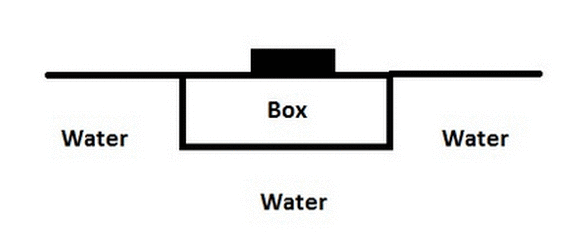
|
|
A
|
The water line will be flush with Surface B
|
B
|
Now that the weight is submerged and facing downward, the entire box will sink
|
C
|
Due to the buoyant force, the box will rotate itself back to the original arrangement
|
D
|
Now that the weight is submerged and facing downward, the water line will be between Surface A and Surface B
|
|
|
|
Tags:
Fluids | Forces | |
|
| 106 |
Go |
Q:
|
"Flour bombing" is a common activity at a lot of airfields where student pilots are learning to fly. It involves filling bags with flour, flying a plane over a marked target, and then dropping the bags to see who can get closest to the target. A student pilot is flying in level flight and must release the flour bag before it is over the target. Ignoring air resistance, which of the following is NOT correct? |
|
A
|
The acceleration of the flour bag is constant
|
B
|
The pilot will be over the target when the flour bag strikes
|
C
|
The flight time of the flour bag is independent of the horizontal speed of the plane
|
D
|
The horizontal velocity of the plane is equal to the vertical velocity of the flour bag when it hits the target
|
|
|
|
Tags:
Kinematics | Forces | |
|
| 107 |
Go |
Q:
|
Two women are pulling on a rope in a tug-of-war. Each woman is pulling on the rope with 200 N forces in opposite directions. Which of the following is correct in regard to the tension in the rope? |
|
A
|
The tension = 0 N
|
B
|
The tension = 200 N
|
C
|
The tension = 400 N
|
D
|
The tension = 600 N
|
|
|
|
Tags:
Forces | |
|
| 108 |
Go |
Q:
|
A tennis ball is launched upward at an angle from starting Point A. Point B is at the top of its parabolic trajectory (the highest position of the ball above the ground), and Point C is when it hits the ground. At which point in its trajectory is the ball's velocity vector changing most rapidly with respect to time? |
|
A
|
Point A |
B
|
A point between Point A and Point C
|
C
|
Point C |
D
|
The change in velocity is the same at any point in the trajectory
|
|
|
|
Tags:
Forces | Kinematics | |
|
| 109 |
Go |
Q:
|
An astronaut is repairing a satellite in space, which is in circular orbit. Which of the following is correct if the astronaut mistakenly leaves his screwdriver outside the satellite after his repairs are complete? |
|
A
|
The screwdriver falls directly to Earth
|
B
|
The screwdriver will fly off into space tangentially
|
C
|
The screwdriver will continue in orbit at the same speed as the satellite
|
D
|
The screwdriver will continue in orbit at a speed slower than the satellite
|
|
|
|
Tags:
Forces | |
|
| 110 |
Go |
Q:
|
Three books are at rest on a table in "pyramid fashion" (largest book on the bottom, medium in the middle, and smallest on top). The bottom book has a weight of 5 N, the middle book has a weight of 4 N, and the top book has a weight of 3 N. Which of the following correctly describes the force acting on the middle book? |
|
A
|
7 N force facing downward
|
B
|
3 N force facing downward
|
C
|
4 N force facing upward
|
D
|
0 N |
|
|
|
Tags:
Forces | |
|
| 111 |
Go |
Q:
|
A truck driver is driving north at a constant velocity. If the truck goes over a piece of mud - which then sticks to one of its tires - which of the following is correct in regard to the initial acceleration of the mud as it leaves the ground? |
|
A
|
The initial acceleration of the mud as it leaves the ground is zero
|
B
|
The initial acceleration of the mud as it leaves the ground is vertically upward
|
C
|
The initial acceleration of the mud as it leaves the ground is horizontally to the north
|
D
|
The initial acceleration of the mud as it leaves the ground is horizontally to the south
|
|
|
|
Tags:
Forces | |
|
| 112 |
Go |
Q:
|
Two men are competing with each other in a game of tug-of-war, with the intention of one man pulling the other man over the middle line. Which of the following is correct with regard to the winner? |
|
A
|
The winner has more mass than the loser |
B
|
While both the winner and loser exert the same force on the rope, the rope exerts a greater force on the loser than it does on the winner |
C
|
The rope exerts the same force on the loser as the loser exerts on the rope; moreover, the rope exerts the same force on the winner as the winner exerts on the rope. However, the force exerted by the winner on the rope is greater than the force exerted by the loser on the rope |
D
|
While both the winner and loser exert the same force on the rope, and the rope exerts the same force on both the winner and loser, the winner exerts a greater frictional force on the ground than the loser |
|
|
|
Tags:
Forces | |
|
| 113 |
Go |
Q:
|
A wheel with radius 40 cm experiences a force of 100 N that acts tangentially on the wheel's rim. The torque is: |
|
A
|
16 Nm
|
B
|
40 Nm
|
C
|
250 Nm
|
D
|
400 Nm
|
|
|
|
Tags:
Forces | |
|
| 114 |
Go |
Q:
|
An elevator is descending down an elevator shaft with constant speed. The elevator is supported by a single cable. Assuming the only forces at play are the tension in the cable and the force of gravity, then: |
|
A
|
the magnitude of the work done by the tension force is larger than the magnitude of the work done by gravity.
|
B
|
the magnitude of the work done by the tension force is smaller than the magnitude of the work done by gravity.
|
C
|
the net work done by the two forces is zero.
|
D
|
the work done by the tension force is zero.
|
|
|
|
Tags:
Forces | Energy & Work | |
|
| 115 |
Go |
Q:
|
An object is placed on a scale and its weight is recorded. How would the recorded weight of the object change as the atmospheric pressure was increased? |
|
A
|
The recorded weight would increase because the air density increases as pressure increases. |
B
|
The recorded weight would increase because air density decreases as pressure increases. |
C
|
The recorded weight would decrease because the air density increases as pressure increases. |
D
|
The recorded weight would decrease because the air density decreases as pressure increases. |
|
|
|
Tags:
Gases | Fluids | Forces | |
|
| 116 |
Go |
Q:
|
A 3kg object is lifted directly upward at a constant velocity of 10 m/s. What is the total upward force on the object neglecting air resistance? |
|
A
|
15 N |
B
|
30 N |
C
|
60 N |
D
|
3 N |
|
|
|
Tags:
Forces | |
|
| 117 |
Go |
Q:
|
A person is using a wrench to turn a bolt which requires 220 Nm of torque. The person is only able to apply 110 Nm of torque with the setup and the strength of their arms. What modification would allow the person to achieve a torque of 220 Nm? |
|
A
|
Increase the length of the wrench by 50%. |
B
|
Decrease the length of the wrench by a factor of two. |
C
|
Extend the length of the wrench by a factor of two. |
D
|
Decrease the length of the wrench by 25%. |
|
|
|
Tags:
Forces | |
|
| 118 |
Go |
Q:
|
A charged particle moving in the same direction as a magnetic field would experience: |
|
A
|
a force in the same direction as the magnetic field. |
B
|
a force in the opposite direction as the magnetic field. |
C
|
a force perpendicular to the magnetic field. |
D
|
no force due to the magnetic field. |
|
|
|
Tags:
Forces | Magnetism | |
|
| 119 |
Go |
Q:
|
A lead sphere with a volume of 1 mL and a silicon sphere with a volume of 1 mL are dropped into water. What is the buoyant force on each sphere? Note: the density of lead is 11 g/mL and the density of silicon is 2.3 g/mL. |
|
A
|
The buoyant force is 0.11 N on the lead sphere and 0.023 N on the silicon sphere. |
B
|
The buoyant force is 0.00091 N on the lead sphere and 0.0043 N on the silicon sphere. |
C
|
The buoyant force on both spheres 11 N. |
D
|
The buoyant force on both spheres is 0.01 N. |
|
|
|
Tags:
Fluids | Forces | |
|
| 120 |
Go |
Q:
|
Which of the following expresses the correct units of pressure? |
|
A
|
kg/m2 |
B
|
kg/(m*s2) |
C
|
kg*m2 |
D
|
kg/(m*s) |
|
|
|
Tags:
Forces | |
|
| 121 |
Go |
Q:
|
A spring stretches to a total length of 5cm to a 2kg mass and stretches to 7.5cm when a 3kg mass is applied. Which of the following represents the spring constant for this spring? |
|
A
|
4 N/cm |
B
|
5 N/cm |
C
|
6 N/cm |
D
|
8 N/cm |
|
|
|
Tags:
Forces | |
|
| 122 |
Go |
Q:
|
A rope of length L holds a weight of weight W. The tension at 1/2 the length of the rope is T. Which of the following is the tension at 3/4 the length of rope (i.e. 1/4L away from the weight)? |
|
|
|
|
Tags:
Forces | |
|
| 123 |
Go |
Q:
|
A door of a house measures 1 meter x 3 meters in size. Pressure outside of the home is 105 pascal units and is the same as the pressure inside the home. Which of the following is the net force on the door? |
|
A
|
0 N |
B
|
3 x 105 N |
C
|
9 x 105 N |
D
|
3 N |
|
|
|
Tags:
Forces | |
|
| 124 |
Go |
Q:
|
An 8m massless pole hangs by a string attached 50cm from the right end of the pole. To hang a 10kg mass in rotational equilibrium on the right end, approximately what force must be applied to the left end of the pole? Assume that this system is with respect to Earth's gravitational field. |
|
A
|
35 N |
B
|
85 N |
C
|
1.2 N |
D
|
6.5 N |
|
|
|
Tags:
Forces | |
|
| 125 |
Go |
Q:
|
Which of the following is the normal force on a block of mass 10kg resting on an inclined plane of angle 45 degrees? Assume that the acceleration due to gravity is 10 m/s2. |
|
|
|
|
Tags:
Forces | |
|
| 126 |
Go |
Q:
|
A string is fixed around a frictionless pulley which is fixed to the ceiling. On one end of the rope, a mass of 13 g is placed; on the other end of the rope, sufficient weight is added such that there is no motion of the string through the pulley. Assuming a radius of 1 m for the pulley, which of the following is the torque on the pulley? |
|
A
|
0 N*m |
B
|
0.013 N*m |
C
|
13 N*m |
D
|
26 N*m |
|
|
|
Tags:
Forces | |
|
| 127 |
Go |
Q:
|
Two blocks hang on opposite sides of a pulley with masses of 100kg and 75kg. What is the approximate acceleration of the system if the blocks are released from rest? |
|
A
|
0.5 m/s2 |
B
|
1.5 m/s2 |
C
|
3 m/s2 |
D
|
4 m/s2 |
|
|
|
Tags:
Forces | |
|
| 128 |
Go |
Q:
|
The spring constant for a spring has units of: |
|
A
|
unitless |
B
|
N |
C
|
N/m |
D
|
m/N |
|
|
|
Tags:
Forces | |
|
| 129 |
Go |
Q:
|
A cyclist racing uphill struggles against the frictional force of the road. The frictional force is calculated from: |
|
A
|
the product of frictional force and the force on the cyclist in the downward direction. |
B
|
the force on the cyclist in the upward direction. |
C
|
the product of frictional force and the force on the cyclist perpendicular to the road. |
D
|
the product of frictional force and the force on the cyclist in the upward direction parallel to the road. |
|
|
|
Tags:
Forces | |
|
| 130 |
Go |
Q:
|
For a bicycle traveling in the rightward direction along the x-axis on a surface where frictional forces are significant: |
|
A
|
both static and kinetic friction are zero. |
B
|
there is no static friction. |
C
|
static and kinetic friction vectors are both positive and in the same direction. |
D
|
static and kinetic friction vectors are both positive and in opposite directions. |
|
|
|
Tags:
Forces | |
|
| 131 |
Go |
Q:
|
A 5kg mass is tied to the end of a 1m string which is spun in circles of 60 rotations per minute. What change in tension of the string would be expected if the string is then spun at 120 rotations per minute? |
|
A
|
increase 2-fold |
B
|
increase 4-fold |
C
|
decrease 2-fold |
D
|
decrease 4-fold |
|
|
|
Tags:
Forces | |
|
| 132 |
Go |
Q:
|
A ball of mass M is spun in a circle at the end of a string of length R. If both M and R double, what would happen to the centripetal force if velocity of the ball remains the same? |
|
A
|
become one-quarter of previous |
B
|
become one-half of previous |
C
|
double |
D
|
remain the same |
|
|
|
Tags:
Forces | |
|
| 133 |
Go |
Q:
|
Which of the following holds true regarding escape velocity with respect to Earth? |
|
A
|
it is not proportional to the mass of the individual object achieving escape velocity |
B
|
it is not proportional to the mass of Earth |
C
|
it is not proportional to the radius of Earth |
D
|
it refers to the speed where an object will remain in orbit around a body and will not drift closer or further from the central object of mass |
|
|
|
Tags:
Forces | |
|
| 134 |
Go |
Q:
|
Imagine someone slides a large box of books down an inclined plane. The box slides the whole length of the plane at a constant velocity. This occurs because: |
|
A
|
the static frictional force opposing the motion of the box equals the gravitational force down the plane. |
B
|
the kinetic frictional force acting on the box and the gravitational force down the plane cancel one another. |
C
|
the box's mass is not sufficient to accelerate the box down the inclined plane. |
D
|
both the box and the inclined plane are frictionless. |
|
|
|
Tags:
Forces | |
|
|
We can teach you how to crush the MCAT!
Learn More
|









